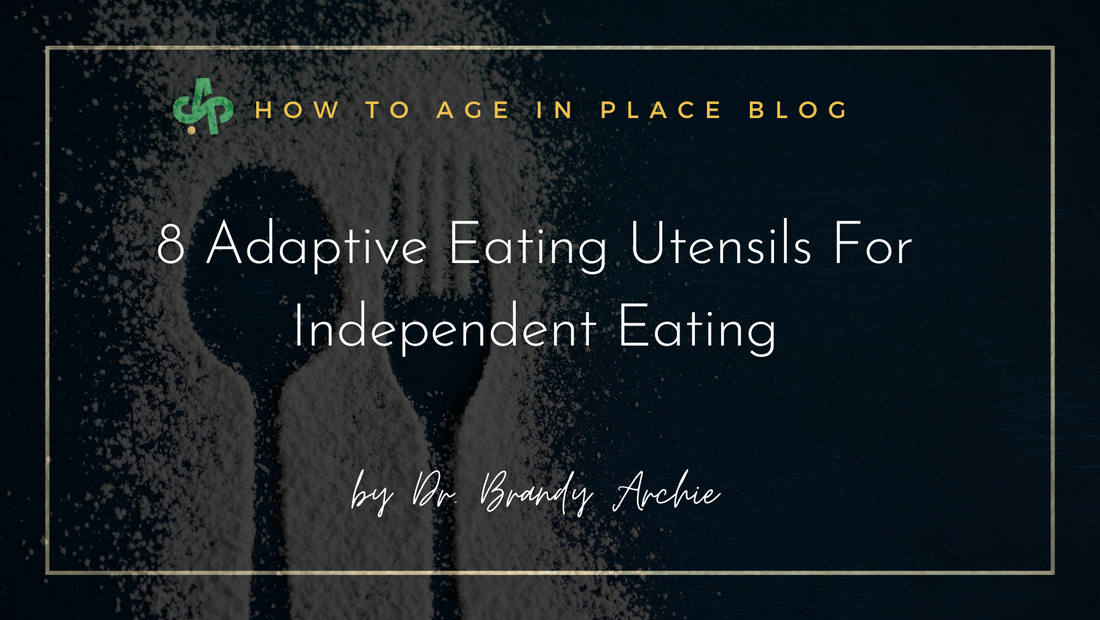Eating is a primary occupation! We come out of the womb knowing how to eat and where to try to find food. Similarly, it's one of the first activities we learn to do independently. So it makes sense that we also take it for granted, until we realize that it can easily be a real challenge for those with physical disabilities, motor impairments, and cognitive issues.
Fortunately, adaptive eating utensils are designed to help people feed themselves more easily and confidently. In this blog post, we'll look at the different types of adaptive eating utensils available, why they are important, as well as who would benefit the most from using them. Plus, if you need help finding the right equipment for yourself or someone else in your life, AskSAMIE can provide you with the assistance you need. And if you find these tips helpful, sign up for our weekly newsletter to stay up to date on all the newest equipment and resources. Let's dig in!
What are Adaptive Eating Utensils?
Adaptive eating utensils are specialized tools designed to help individuals with physical disabilities, motor impairments, and cognitive issues to independently feed themselves. These specially designed items come in a variety of shapes, sizes, and colors to fit the individual's needs. From forks and spoons for those with limited grip strength, to knives with oversized handles for those who need extra leverage when cutting food, there's an adaptive eating utensil out there for every user.
For those who have difficulty keeping their plates from slipping around on the table, there are plates and bowls with suction cups on the bottom that securely adhere them to surfaces during meal times. To provide comfort and usability, all adaptive eating utensils feature ergonomic designs that make it easier for users to hold onto them while they eat.
This makes it possible for many people to enjoy meals without assistance or help from others, giving back independence and dignity in something we do multiple times everyday.
That feeling of independence and sense of agency is incredibly empowering. In my work, I've witnessed how creating an independent eating setup can be a gateway to the motivation needed to tackle another hard task ans find a way to become more independent. Independence with eating has a ripple effect. I'm highlighting this because so many well-meaning people help heavily with eating, trying to be caring and compassionate. I'd argue that finding all the ways to make eating easier, even if it still requires a little struggle, is the most caring thing you can do because the dignity tied to eating has such a massive impact on the way we think, feel, and act about ourselves.
If it feels overwhelming trying to figure out the right equipment for yourself or someone in your life, AskSAMIE is here to provide you with the guidance and resources you need. Not only do we have the products you need, but we also have tools that help you figure out what would be the perfect fit to meet the individual needs and ensure independent mealtime success!
Whether it's using forks with larger loops on one end of the handle for better gripping power or chopsticks specially designed like tongs so they don't require as much dexterity when picking up food particles – adaptive eating utensils make it possible for everyone to enjoy their favorite foods regardless of physical limitations!
Who Uses Adaptive Eating Utensils?
Adaptive eating utensils are an invaluable tool for those with physical or cognitive limitations who wish to maintain their independence and dignity. Whether it's a child, older adult, or caregiver of someone with a disability, having the right adaptive eating utensil can make all the difference at the dinner table.
Some of the most common reasons for using adaptive eating utensils include:
- having a physical disability like Cerebral Palsy or Multiple Sclerosis
- motor impairments caused by neurological conditions like stroke or Parkinson's disease
- changes in function after surgery or other medical treatments
- having a cognitive or memory deficits that impacts attention to eating
8 types of adaptive eating utensils
Adaptive eating utensils come in a variety of shapes and sizes to suit the needs of all users. Here's the ones we recommend the most often.
-

Weighted utensils -
Help with slowing tremors that are keeping someone from bringing the food from the plate to their mouth. You can add weight to the utensil itself or on the wrist or upper arm with a weighted bracelet and gain the same effect. -
Bendable utensils
- Can be bent at different angles for better reach. This is especially useful when the way the hand can come to the mouth isn't quite level with keeping the spoon upright or angled toward the mouth. -
Built-up handles
- For those who have trouble gripping, built-up handles increase control over the tool and make it easier to hold. -
Rocker knives
- help cut food into smaller pieces with less force, which allows it to be done with one hand. Move the knife with an easy back and forth rocking motion instead of trying to stabilize the food with a fork and using the knife in a sawing motion. -

Swivel spoons
- accommodate for tremors by shaking opposite the way the hand is shaking. This counteracts the force on the food so it stays on the spoon while on its way to the mouth. This is especially useful for those with essential tremors or Parkinson's. Swivel spoons can be simple or battery-powered with tech built in to make it as effective as possible. -
S'up spoon
- is in a category all its own! It's like a miniature cup attached to a spoon handle. So as you scoop food, it stays contained in the cup on its way to the mouth. This helps a lot when tremors, involuntary jerks, or just a lack of coordination are the reason for trouble with eating. -
Red Tableware
- is great for individuals with dementia who's lack ofattention keeps them from eating and drinking as much as they need. Studies show that red plateware helps people eat up to 24% more food and drink 84% more because of the high contrast to most place settings.
-
Suction plates & bowls
- I'm including plates and bowls because if you can't keep food in place, it's really hard to eat independently. We like to recommend Gel Pads as a Dycem alternative to be placed under the bowls and plates you already have so they stay put and can be used with all kinds of things that need to stay put.
Need Help Finding The Right Equipment?
Finding the right adaptive eating utensil can be challenging. Fortunately, AskSAMIE offers both on-demand assessments and virtual visits with an occupational therapist. In both instances, you get the clinical knowledge you need to guide you to the adaptive eating utensils that are best suited to the individual's needs. With our help, you can find the right equipment to ensure that the person has access to independent eating without wasting a bunch of time or money trying multiple things.
Our free On Demand Assessment lets you answer a few questions about the problems the person is having and instantly have a list of adaptive equipment that can meet the needs.
AskSAMIE also offers virtual visits with occupational therapists who specialize in helping those with physical disabilities regain independence through adaptive techniques. Schedule with a couple clicks, and connect with us via video chat from your phone or tablet. It's easy and we'll make sure the tech doesn't get in the way.
By providing customized solutions, tailored to each person's specific needs, we make it easier than ever for people to gain independence and enjoy their meals again.



